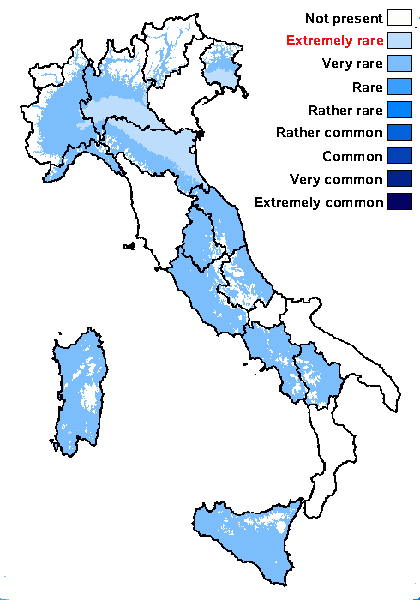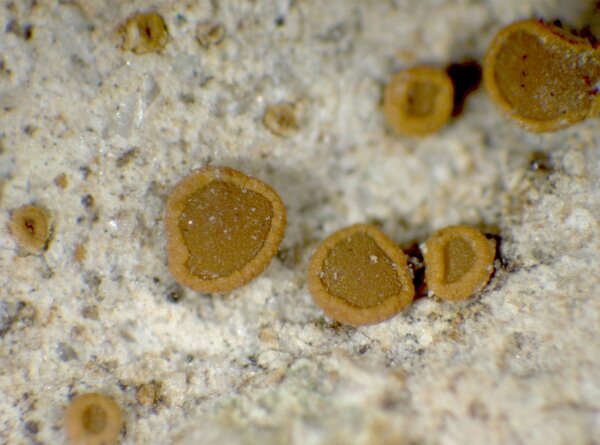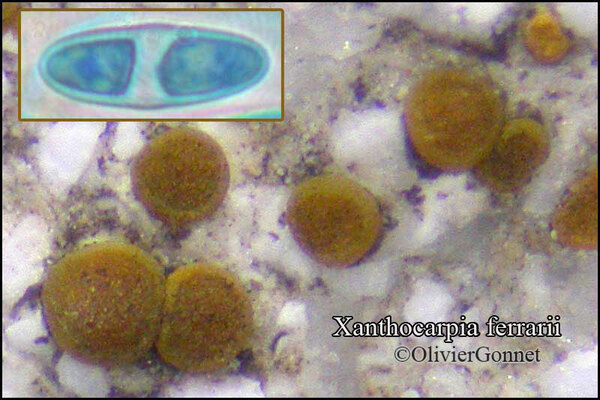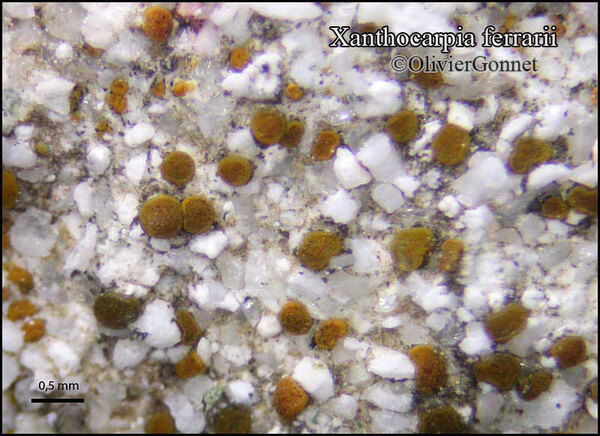Xanthocarpia ferrarii (Bagl.) Frödén, Arup & Søchting
in Arup & al., Nord. J. Bot., 31: 57, 2013. Basionym: Callopisma ferrarii Bagl. - Mem. Accad. Sc. Torino, 2, 17: 406, 1858.
Synonyms: Caloplaca ferrarii (Bagl.) Jatta; Caloplaca ferrarii var. pura J. Steiner
Distribution: N - Frl, TAA (Nascimbene 2003, 2004), Lomb (Nascimbene 2006, Sunil Morgan & al. 2008), Piem, VA (Piervittori & Isocrono 1999), Emil (Tretiach & al. 2008, Fariselli & al. 2020), Lig (TSB 33069). C - Marc (Nimis & Tretiach 1999), Umb (Genovesi & al. 2002, Ravera & al. 2006), Laz (Bartoli & al. 1998), Abr (Nimis & Tretiach 1999), Sar (Rizzi & al. 2011). S - Camp (Aprile & al. 2003b, Garofalo & al. 2010), Bas (Nimis & Tretiach 1999), Si (Monte & Ferrari 1996).
Description: Thallus crustose, poorly evident or reduced to a few ochraceous granules around the apothecia, reacting K-. Apothecia 0.7-1.5(-2) mm across, sessile, with a flat to slightly convex, orange-pruinose disc, and a concolorous or slightly paler, thin, persistent margin; thalline margin usually not developed, or reduced to a few granules at the base of apothecia. Proper exciple prosoplectenchymatous, swollen, c. 120-150 μm thick, the cells with very small lumina; epithecium brownish orange, K+ red, C-; hymenium colourless, c. 100 μm high; paraphyses simple or sparingly branched in upper part, c. 2 μm thick at base, the apical cells swollen, up to 5 μm wide. Asci 8-spored, clavate, functionally unitunicate, apically thickened with a broad internal beak, the inner part of apex and external cap I+ blue, Teloschistes-type. Ascospores 2-celled, polarilocular, hyaline, ellipsoid, 16-23(-26) x /4.5-)6-8 μm, the equatorial thickening (“septum”) 1-2(-3) μm. Photobiont chlorococcoid. Spot test: thallus K-, C-, KC-, P-; apothecia K+ dark red, C-. Chemistry: apothecia with parietin (major), fallacinal, emodin, teloschistin and parietinic acid (minor), corresponding with chemosyndrome A of Søchting (1997). Note: a temperate early coloniser of mortar walls, gypsum outcrops and other calciferous, often man-made, soft substrata at relatively low elevations. Recently, this taxon was shown to be paraphyletic and to contain at least two lineages (Vondrák & al. 2011).
Growth form: Crustose
Substrata: rocks
Photobiont: green algae other than Trentepohlia
Reproductive strategy: mainly sexual
Pioneer species
Commonnes-rarity: (info)
Alpine belt: absent
Subalpine belt: absent
Oromediterranean belt: absent
Montane belt: absent
Submediterranean belt: very rare
Padanian area: extremely rare
Humid submediterranean belt: very rare
Humid mediterranean belt: very rare
Dry mediterranean belt: very rare

Predictive model
Herbarium samples
Growth form: Crustose
Substrata: rocks
Photobiont: green algae other than Trentepohlia
Reproductive strategy: mainly sexual
Pioneer species
Commonnes-rarity: (info)
Alpine belt: absent
Subalpine belt: absent
Oromediterranean belt: absent
Montane belt: absent
Submediterranean belt: very rare
Padanian area: extremely rare
Humid submediterranean belt: very rare
Humid mediterranean belt: very rare
Dry mediterranean belt: very rare

Predictive model
| Herbarium samples |
 INDEX FUNGORUM
INDEX FUNGORUM
 GBIF
GBIF
 DOLICHENS
DOLICHENS






